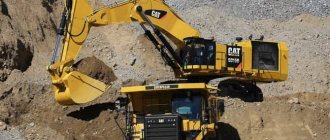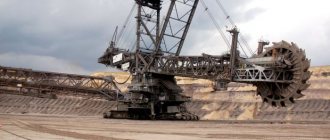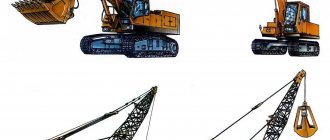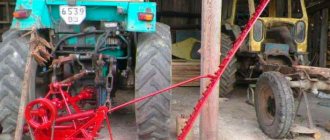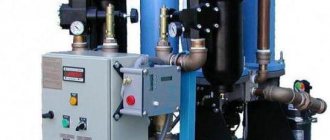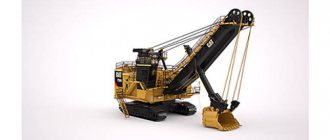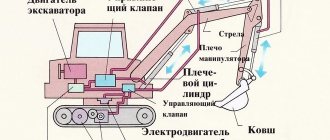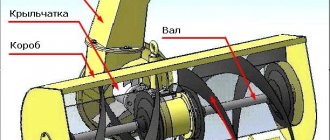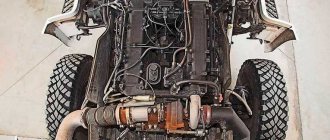Dragline excavators are a huge type of special machine for various types of digging and lifting large-volume earthworks. They are produced on the basis of tracked and wheeled chassis or walking. As working equipment, they can have a single bucket, a boom, all kinds of winches (lifting and traction), a wedge ripper, and power pulley systems. They also have a simpler “folk” name – “tyanusha”. They make it possible to reduce the labor intensity of earth-moving work and the cost of overburden production by 3-4 times.
Dragline is a heavyweight among special equipment
Despite its modern sound, “dragline” is not a new word on the special equipment market. The idea of creation belongs to the great Renaissance inventor Leonardo da Vinci. At the beginning of the 14th century, he put forward the idea of constructing a similar unit. A similar device was built in the USA in 1884, and the equipment was released to the masses in the USSR since 1946. It was first used for mining. And later it began to be used in other areas. Modern dragline excavators are very efficient and productive. They are able to cope with the most complex excavation work, and therefore have become an integral part of reclamation and large-scale construction activities.
Walking
The most powerful vehicles with Dragline equipment weigh tens and hundreds of thousands of tons, and when installed on tracked (and even more so wheeled) chassis, the load on the site becomes too great.
To avoid this, the support area of the excavator was maximized, and its movement was set to a “walking stroke” with a hydraulic drive (for some machines a crank-lever or mechanical drive is used). One “step” occurs in two stages: When stationary, such a machine stands on a wide support platform.
If movement is necessary, the weight of the excavator is transferred to special “skis” (“shoes”), controlled by pairs of hydraulic cylinders. He moves one “step” and sits down again on the support platform.
By performing these two operations alternately, the Dragline can move at a speed of no more than 100 meters per hour. This is enough for a slight change in its location relative to the quarry being developed.
IMPORTANT! If it is necessary to transport walking excavators over distances of up to 80 km, heavy-duty transporters are used, and for longer transportation the machine must be disassembled and transported in parts.
At the moment, it is “walking” dragline excavators that have become most widespread and popular, pushing tracked and wheeled models into the past.
This is interesting: Excavator EO-2621: technical characteristics, fuel consumption
Dragline design features
This type of special equipment is nothing more than a single-bucket excavator. But at the same time, it has significant differences in design. The boom, whose length reaches 110 m, is connected to the bucket using a cable mechanism. Digging is one-sided. Cyclic machine. The suspension of the bucket is flexible, and the boom is quite light - these characteristics allow you to cover a large radius of the processed area, maximum unloading height and the greatest digging depth.
The main difference from excavators is the cable mechanism. It is this that expands the capabilities of technology, facilitates control, allows you to work with complex arrays and get to remote and hard-to-reach places. And together with a qualified and experienced operator, he performs tasks that are impossible for other equipment.
There are different models of draglines. And their technical characteristics are in a fairly wide range:
- boom length - 15–100 m;
- scooping radius - 15 meters or more;
- bucket capacity - 6–168 m3;
- vehicle weight - up to 8 thousand tons;
- productivity - 570–1210 m3/hour;
- pressure on the ground - 0.06–0.255 MPa.
Draglines come in several types: walking, wheeled, tracked and rack-and-pinion. They most often run on diesel or power lines. When choosing, the operating conditions are taken into account.
Interesting: Draglines don't always look like compact excavators. Along with other special equipment, they have standard sizes. But among them there are real giants. In 1969, American designers built the world's largest dragline and called it “Big Mask.” The bucket volume was 168 m3. Why do we need such a “giant”? To do a job with one swing of the ladle that others would spend hours working on.
Technical specifications
Dragline excavators belong to the heavy class of earth-moving equipment. These machines are widely used all over the world, because they are indispensable in the development of coal deposits and ore deposits. Russia is one of the suppliers of this equipment on the global construction equipment market. The production of machines is carried out by the Uralmash enterprise. The plant specializes in the production of walking draglines marked with ESH. The lineup includes six cars.
The equipment varies in power and performance. More detailed technical specifications will be given in the table. For comparison, the minimum and maximum parameters of the equipment will be given.
| Structural mass | 843-3 420 t |
| Pressure on the soil surface | 0.092-0.191 MPa |
| Base area | 91-254 square meters |
| Hydraulic support size | 1.9-17.2 m |
| Boom length | 75-110 m |
| Bucket volume | 11-40 cubic meters |
| Excavation depth | 38-53 m |
| Performance | 569-1 210 cubic meters/hour |
It is worth noting that the given indicators are not benchmarks. The maximum capacity of a dragline bucket can reach 168 cubic meters, and the average productivity is about 450 tons/hour.
Scope of application: why and how the equipment is used
Draglines can work where other equipment is simply powerless. It is this factor that determines their main advantage. Tasks performed by machines:
- development of soil and its separation from the massif;
- moving and loading material;
- coverage of large-scale ground areas;
- stripping operations (rock removal);
- use in reclamation construction;
- assistance in mining;
- creation of huge quarries and high embankments;
- active participation in hydraulic engineering processes, construction of highways and railways;
- cleaning the bottom of reservoirs.
The scope of their use is not so wide. And all thanks to their working mass. Even the lightest dragline models significantly exceed the weight of machines with a hydraulic drive and a rope-block system. In urban environments they are used extremely rarely.
Devices that change reality
There are different types of excavators, differing in the type of bucket, drive, platform (wheeled or tracked), and size (regular and miniature). Their main task was to replace manual labor in heavy earthworks. It was thanks to these machines that it was possible to increase the pace of construction (both residential and industrial) and the development of natural resources.
Each use of the machine was designed to minimize waste and maximize productivity. Effective techniques increase overall labor efficiency, which means they create added value for manufactured products and move progress further.
After all, excavation work requires up to 50% of all costs for construction or development of open-pit mining sites.
Before ordering a rental excavator, you should consult with experienced engineers or designers, select the brand and type of earthmoving machine, and only then enter into a rental agreement. If you plan to use a universal machine, it is worth calculating at least its most efficient positioning (with the smallest rotation angle).
Important Characteristics of the MAZ-205 dump truck and several new popular modifications
Pros and cons of special equipment
Benefits that increase productivity and significantly reduce costs:
- An elongated and lightweight boom (thanks to it, work can be carried out at a considerable distance from the machine itself).
- Free movement of the dragline working body (this allows you to make the largest possible recesses).
- Large grip radius.
- A very voluminous bucket with a simple control system (reduces costs associated with maintaining equipment, lasts a long time).
Among the disadvantages of this special equipment is the flexible suspension. Despite the fact that the machine creates a large digging force, it is not always able to provide sufficient initial depth. Therefore, in the presence of very hard types of soil, it is necessary to carry out preliminary loosening. There is also a problem with unloading material into vehicles. The accuracy of digging and unloading is low, so most often they use a special dump - a place for dumping soil. Its further movement is carried out by loaders and dump trucks.
Device selection criteria
When determining the criteria for selecting equipment with a dragline, it is important to clearly know what kind of work the equipment is needed for.
A dragline is a certain type of construction equipment that works with soils at great depths. This technique comes in two types:
- Single-bucket batch operation ;
- Single-bucket continuous action .
To choose the right machine, you need to evaluate its operational capabilities. The definition contains types of indexing , where the first letters indicate the class of equipment (EO single-bucket excavator), and then the main indices :
- excavator size (bucket capacity);
- chassis;
- working suspension device;
- serial number of the excavator model.
After determining the main indices, letter indices , which denote serial modernization (A, B), climatic use (C, HL, T, TV).
As for equipment designs, here the designation is digital :
- 1 flexible suspension (rope pulleys);
- 2 rigid suspension (hydraulic cylinders);
- 3 - telescopic.
Excavators with dragline equipment are characterized by productivity and great durability. The only downside is the low digging accuracy due to the flexible suspension.
The presence of a flexible suspension in the working equipment implies dividing it into equipment with a front shovel or a backhoe.
A rigid suspension will allow you to hang a hydraulic hammer on the dragline instead of a bucket, driven by the pumps of the unit’s hydraulic system.
To select the type of unit, the main criteria will be the nature and characteristics of the work it is supposed to perform. And the right choice of car type is very important here.
Equipment on the world market
Over the long history of draglines, manufacturers around the world have produced many models. Some of them did not take root and remained unknown. But there are cars that have been in great demand for decades.
In the Russian Federation, very popular models remain: EO-4112A-1 (cable crawler excavator with attachments from the Ukrainian excavator plant in the city of Donetsk), with ESh equipment (electrical equipment with a volumetric bucket from the machine-building plant in the city of Novokramatorsk), ESh with a 100 m3 bucket and EDG excavators (bucket up to 9 m3) from OMZ Mining Equipment and Technologies.
Foreign equipment from the Japanese manufacturer Hitachi has become very popular. Units with a high level of reliability, robust design, extended boom, and tracked drive are very effective for difficult working conditions and strong massifs.
To understand what a dragline is, you need to see it in action. You can't help but admire them. The massive and powerful design easily copes with any hard rock and masterfully overcomes all the difficulties of the construction process.
Energy supply
Rope excavators require a supply voltage of 3,000 to 10,000 V. This voltage must be supplied directly to the excavator from surface sources several kilometers from the quarry. The cables that power excavators are usually large gauge, heavy, and difficult to move behind the excavator. There is only one rope excavator currently known on the market, which is driven by diesel engines.
The R&H 2650 excavator has two diesel engines of equal power that drive electric generators that produce electricity for the electric motors that drive the winches and the turning mechanism. In addition, diesel engines drive hydraulic pumps to control the bucket and drive the chassis. This excavator is more mobile both when working in the face and when moving around the quarry or from one quarry to another. The manufacturer calls this excavator “hybrid”.
